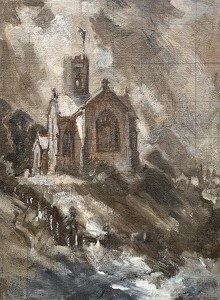

1893-1973
The Seer
Ref: 804
Signed and dated l.l: John Armstrong/1955
Oil on canvas, 61 by 41 cm
Provenance: Annette Armstrong; with the New Grafton Gallery, London; Emscote Lawn collection
Exhibited: the New Art Centre, London, 1977, John Armstrong, no.4; Fermoy Art Gallery, King’s Lynn, 1977, John Armstrong Paintings, no.8
Literature: Andrew Lambirth et al., John Armstrong: The Complete Paintings, London, 2009, no.531

(price on request)Enquire
In the 1930s Armstrong was a significant member of Unit One, a group formed by his fellow artist Paul Nash to promote modern art, architecture and design. The group had a significant role in organising the International Surrealist Exhibition in 1936 and it is perhaps for this reason that Armstrong’s work takes on strongly surrealist quality from the 1930s. As well as soon establishing himself as one of the most international British painters of his day, Armstrong enjoyed a particularly distinguished career as a designer working for most of Alexander Korda’s productions in the 1930s including Henry VIII, The Scarlet Pimpernel and Rembrandt and the whimsical English ballet Façade.
In The Seer, a solitary contemplative female figure leans on a Classical column and stares out onto a seemingly endless empty sea beyond. Painted in 1955, a year of great turmoil for Armstrong, it is one of a number of works from the period that dwells on the subject of voyage and departure. The primary inspiration for such work was the end of the marriage to his second wife Veronica Sibthorp in the same year and the move from Lamorna in Cornwall where the couple had lived for the previous ten years. Armstrong’s split from Veronica was a particularly antagonistic and unhappy one, exemplified by a number of relationships she had had, including one with the Welsh poet, Dylan Thomas. Armstrong was nevertheless able to direct his feelings into a series of great and monumental works of which The Seer is one. The artist returns here to the distinctive and original brushwork seen in his paintings of the mid 1940s, whilst maintaining oil, which had replaced tempera in about 1950, as his medium of choice. I am grateful to Jonathan Gibbs for his assistance in cataloguing this painting.




